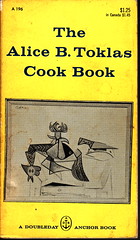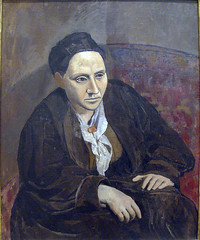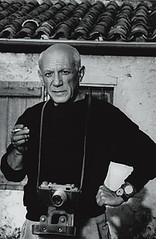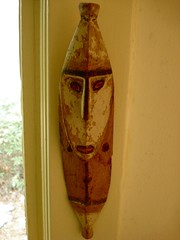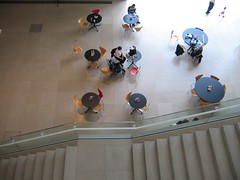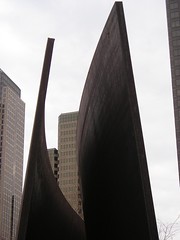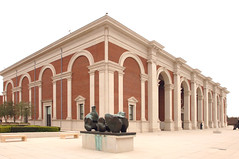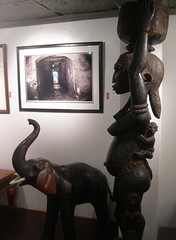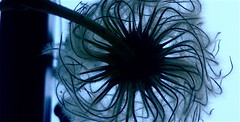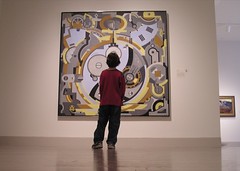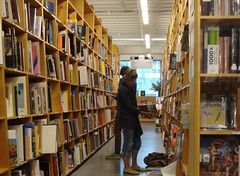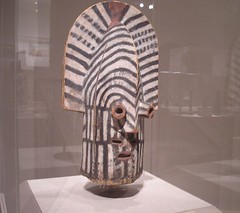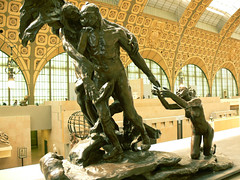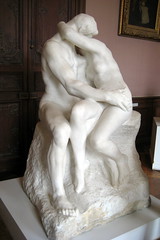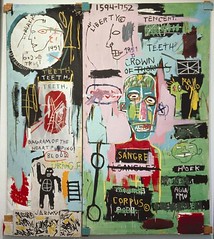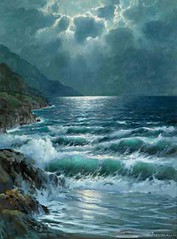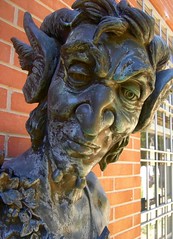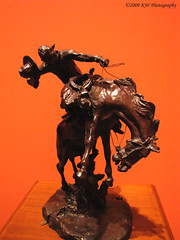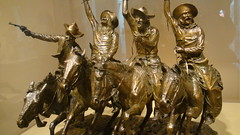Magnet's founder, Mrs. Ascension Delgado-Arias Smith, was born and raised in Seville, Spain. Her school was a classic European private academy and she knew that it would be an effective model for an American magnet school. So Magnet was partly birthed in Sevilla, in the region called Andalusia.
Most of Spanish was an African colony from 711 to 1492 CE. It was controlled by the African Arabic/Berber Muslims known as the Moors. The Islamic invaders engendered lovely creations in the arts (architecture, music, design, etc). And they called Southern Spain, home to both Ascension Smith and Pablo Picasso, Al Andalus (Andalusia).
Also important to Picasso's life was his time in Barcelona. Of course, he went to Madrid for his major period of study. Following his time in Madrid he moved to Paris and did not look back.
Wednesday, September 30, 2009
Picasso and a celebrated guide to European cuisine: The Alice B. Toklas Cook Book
From the Amazon.com Review:
First published in 1954, The Alice B. Toklas Cookbook is one of America's great works of recollection, culinary and otherwise. Toklas lived, cooked, and kept house in Paris and rural France with her companion, Gertrude Stein, from 1908 until Stein's death in 1947. During that time she cooked for and shared food with friends, including Pablo Picasso, Ernest Hemingway, and Thornton Wilder, accumulating recipes for the simple and haute bourgeois dishes compiled in the book.
She also saw and remembered all, from life in the high bohemian circle she and Stein occupied; to France during two world wars; to the United States, visited in the '30s; to summers passed in a paradisical country retreat at Biligin in France. These and more Toklas depicts vividly and acerbically, all viewed through the prism of food and good eating.
Woven within chapters such as "Dishes for Artists," "Food in French Homes," and "The Vegetable Gardens at Biligin," the 300 recipes run the gamut from hors d'oeuvres and salads to breads, entrées, drinks, and sweets. Original (and sometimes whimsical) dishes like Stuffed Artichokes Stravinsky, Gigot de la Clinque, and Bavarian Cream Perfect Love appear among more traditional offerings, such as Boeuf Bourguignon, Chicken à l'Estargon, and Green Peas à la Goodwife. Many of the recipes (which are written in abbreviated-narrative style) will be attempted only by adventurous cooks with time (and, in some cases, money) to spare. The rest of us will enjoy reading the recipes, the droll reminiscences, and the fantasizing about a time when the dishes' creation could be relatively commonplace. The tour of this era and its food, by one of literature's great cook-writers, is obligatory reading. --Arthur Boehm
Also notable to my generation: her recipe for Hashish Fudge (!).
First published in 1954, The Alice B. Toklas Cookbook is one of America's great works of recollection, culinary and otherwise. Toklas lived, cooked, and kept house in Paris and rural France with her companion, Gertrude Stein, from 1908 until Stein's death in 1947. During that time she cooked for and shared food with friends, including Pablo Picasso, Ernest Hemingway, and Thornton Wilder, accumulating recipes for the simple and haute bourgeois dishes compiled in the book.
She also saw and remembered all, from life in the high bohemian circle she and Stein occupied; to France during two world wars; to the United States, visited in the '30s; to summers passed in a paradisical country retreat at Biligin in France. These and more Toklas depicts vividly and acerbically, all viewed through the prism of food and good eating.
Woven within chapters such as "Dishes for Artists," "Food in French Homes," and "The Vegetable Gardens at Biligin," the 300 recipes run the gamut from hors d'oeuvres and salads to breads, entrées, drinks, and sweets. Original (and sometimes whimsical) dishes like Stuffed Artichokes Stravinsky, Gigot de la Clinque, and Bavarian Cream Perfect Love appear among more traditional offerings, such as Boeuf Bourguignon, Chicken à l'Estargon, and Green Peas à la Goodwife. Many of the recipes (which are written in abbreviated-narrative style) will be attempted only by adventurous cooks with time (and, in some cases, money) to spare. The rest of us will enjoy reading the recipes, the droll reminiscences, and the fantasizing about a time when the dishes' creation could be relatively commonplace. The tour of this era and its food, by one of literature's great cook-writers, is obligatory reading. --Arthur Boehm
Also notable to my generation: her recipe for Hashish Fudge (!).
Tuesday, September 29, 2009
Picasso and the American writer and art collector Gertrude Stein, 1906
"Picasso discovered ancient Iberian sculpture from Spain, African art (for he haunted the African collections in the Musée d'Ethnographie du Trocadéro in Paris), and Gauguin's sculptures. Slowly, he incorporated the simplified forms he found in these sources into a striking portrait of Gertrude Stein, finished in 1906 and given by her in her will to the Metropolitan Museum. She has a severe masklike face made up of emphatically hewn forms compressed inside a restricted space. (Stein is supposed to have complained, "I don't look at all like that," with Picasso replying, "You will, Gertrude, you will.") This unique portrait comes as a crucial shift from what Picasso saw to what he was thinking and paves the way to Cubism.
The sittings for this famous portrait took place in Picasso's cold studio in Paris, where the 31 year old Stein (1874-1946) in a rickety armchair, a warm brown coat covering her majestic bulk. Picasso portrayed her in the masculine, self-assured posture of the newspaper tycoon Louis-Francois Bertin.
Picasso had been impressed by the sharp mind and free manner of this American writer and collector--she would become one of his most important patrons--and he offered to paint her portrait. In autumn 1905, the many sittings began. In spring 1906, dissatisfied with the face, Picasso painted it out. When he returned to Paris that autumn, he painted, without Stein's presence, this mask like visage. Picasso was bold in grafting a proto-Cubist head on Steins late Rose Period body, creating a startlingly unique and iconic image.
The sittings for this famous portrait took place in Picasso's cold studio in Paris, where the 31 year old Stein (1874-1946) in a rickety armchair, a warm brown coat covering her majestic bulk. Picasso portrayed her in the masculine, self-assured posture of the newspaper tycoon Louis-Francois Bertin.
Picasso had been impressed by the sharp mind and free manner of this American writer and collector--she would become one of his most important patrons--and he offered to paint her portrait. In autumn 1905, the many sittings began. In spring 1906, dissatisfied with the face, Picasso painted it out. When he returned to Paris that autumn, he painted, without Stein's presence, this mask like visage. Picasso was bold in grafting a proto-Cubist head on Steins late Rose Period body, creating a startlingly unique and iconic image.
Why is Pablo Picasso called the greatest artist of the 2oth century?
Pablo Diego José Francisco de Paula Juan Nepomuceno María de los Remedios Cipriano de la Santísima Trinidad Ruiz y Picasso (25 October 1881 – 8 April 1973) was a Spanish painter, draughtsman, and sculptor, says Wikipedia.
Commonly known simply as Picasso, he is one of the most recognized figures in 20th-century art. He is best known for co-founding the Cubist movement and for the wide variety of styles embodied in his work. Among his most famous works are the proto-Cubist Les Demoiselles d'Avignon (1907) and Guernica (1937), his portrayal of the German bombing of Guernica during the Spanish Civil War.
Picasso demonstrated uncanny artistic talent in his early years, painting in a realistic manner through his childhood and adolescence; during the first decade of the twentieth century his style changed as he experimented with different theories, techniques, and ideas.
Picasso’s creative genius manifested itself in numerous mediums, including painting, sculpture, drawing, and architecture. His revolutionary artistic accomplishments brought him universal renown and immense fortunes throughout his life, making him the best-known figure in twentieth century art. His fame has continued after his death, firmly establishing his status as one of the greatest artists in Western history.
Please continue reading.
Read more here.
Commonly known simply as Picasso, he is one of the most recognized figures in 20th-century art. He is best known for co-founding the Cubist movement and for the wide variety of styles embodied in his work. Among his most famous works are the proto-Cubist Les Demoiselles d'Avignon (1907) and Guernica (1937), his portrayal of the German bombing of Guernica during the Spanish Civil War.
Picasso demonstrated uncanny artistic talent in his early years, painting in a realistic manner through his childhood and adolescence; during the first decade of the twentieth century his style changed as he experimented with different theories, techniques, and ideas.
Picasso’s creative genius manifested itself in numerous mediums, including painting, sculpture, drawing, and architecture. His revolutionary artistic accomplishments brought him universal renown and immense fortunes throughout his life, making him the best-known figure in twentieth century art. His fame has continued after his death, firmly establishing his status as one of the greatest artists in Western history.
Please continue reading.
Read more here.
Monday, September 28, 2009
Field trip to SUMAS delayed until Thurs
Because of my illness I am going to try to reschedule our field trip to SUMAS.
Hopefully we can visit the 610 Texas St site on Thurs.
Hopefully we can visit the 610 Texas St site on Thurs.
Henri Matisse, Pablo Picasso among the modernists influenced by African art
During the early 1900s, the aesthetics of traditional African sculpture became a powerful influence among European artists who formed an avant-garde in the development of modern art, says the Metropolitan Museum.
In France, Henri Matisse, Pablo Picasso, and their School of Paris friends blended the highly stylized treatment of the human figure in African sculptures with painting styles derived from the post-Impressionist works of Cézanne and Gauguin. The resulting pictorial flatness, vivid color palette, and fragmented Cubist shapes helped to define early modernism.
While these artists knew nothing of the original meaning and function of the West and Central African sculptures they encountered, they instantly recognized the spiritual aspect of the composition and adapted these qualities to their own efforts to move beyond the naturalism that had defined Western art since the Renaissance.
Please continue reading.
Additionally, please explore the National Museum of African Art.
In France, Henri Matisse, Pablo Picasso, and their School of Paris friends blended the highly stylized treatment of the human figure in African sculptures with painting styles derived from the post-Impressionist works of Cézanne and Gauguin. The resulting pictorial flatness, vivid color palette, and fragmented Cubist shapes helped to define early modernism.
While these artists knew nothing of the original meaning and function of the West and Central African sculptures they encountered, they instantly recognized the spiritual aspect of the composition and adapted these qualities to their own efforts to move beyond the naturalism that had defined Western art since the Renaissance.
Please continue reading.
Additionally, please explore the National Museum of African Art.
Friday, September 25, 2009
African collection by Leon Tarver: Southern Museum of Art, Shreveport
Much of the work of Africa is in wood. Sculpture, drums, jewelry, etc.
Among the most notable woods associated with Africa:
Ebony is a general name for very dense black wood. In the strict sense it is yielded by several species in the genus Diospyros, but other heavy, black (or dark colored) woods (from completely unrelated trees) are sometimes also called ebony.
Ebony is one of the most intensely black woods known, which, combined with its very high density (it is one of the woods that sink in water), fine texture, and ability to polish very smoothly, has made it very valuable as an ornamental wood.
Ebony has a long history of use, with carved pieces having been found in Ancient Egyptian tombs. The word "ebony" derives from the Ancient Egyptian hbny, via the Ancient Greek ἔβενος (ébenos), by way of Latin and Middle English.
By the end of the 16th century, fine cabinets for the luxury trade were made of ebony in Antwerp. The dense hardness lent itself to refined moldings framing finely detailed pictorial panels with carving in very low relief (bas-relief), usually of allegorical subjects, or scenes taken from classical or Christian history. Within a short time, such cabinets were also being made in Paris, where their makers became known as ébénistes, which remains the French term for a cabinetmaker.
Modern uses are largely restricted to small sizes, particularly in musical instrument making, including piano and harpsichord keys, violin, viola, guitar, and cello fingerboards, endpieces, pegs and chinrests. Traditionally, black piano and harpsichord keys were ebony, and the black pieces in chess sets were made from ebony, with rare boxwood or ivory being used for the white pieces.
Teak (Tectona), is a genus of tropical hardwood trees in the mint family, Lamiaceae[1][2][3], native to the south and southeast of Asia, and is commonly found as a component of monsoon forest vegetation. They are large trees, growing to 30-40 m tall, deciduous in the dry season.
The name teak comes from the Malayalam[4] word Thekku.
The yellowish brown timber with good grains and texture from teak trunk is used in the manufacture of outdoor furniture, boat decks, and other articles where weather resistance is desired. It is also used for indoor flooring and as a veneer for indoor furnishings.
Teak is easily worked and has natural oils that make it suitable for use in exposed locations and termite and pest proof, where it is durable even when not treated with oil or varnish. Timber cut from old Teak trees grown slowly in natural forests is more durable and harder; teak from young trees grown in plantations is more prone to splitting and water damage, however kiln drying allows for sustainable, plantation-grown teak to perform nearly on par with old-growth teak.
The name mahogany is used when referring to numerous varieties of dark-coloured hardwood, it is an American Indian word originally used for the wood of the species Swietenia mahagoni, known as West Indian or Cuban mahogany.
Mahogany has a generally straight grain and is usually free of voids and pockets. It has a reddish-brown color, which darkens over time, and displays a beautiful reddish sheen when polished. It has excellent workability, and is very durable. The size of the trees meant that wide boards were once available (and still are of the non-endangered varieties). These properties make it a favourable wood for crafting furniture.
Much of the first-quality furniture made in the American colonies from the mid 1700s, when the wood first became available to American furniture makers, was made of mahogany. Mahogany resists wood rot, which makes it suitable for boat construction. It is also often used for musical instruments, particularly the backs of guitars.
Mahogany is used for drum making, because of its integrity and capability to produce a very dark, warm tone (as compared to other more common wood types like maple or birch).
A wide variety of electric guitars are also made with mahogany, like Gibson's Les Paul.
Mahogany is also commonly used in acoustic guitars. The wood is most often used to make the back, sides, or neck of a guitar, but it is sometimes used to make the top (soundboard) as well. Guitars with mahogany soundboards tend to have a softer, darker tone than those made from spruce.
Bubinga: The best-known Guibourtia timber is bubinga (Guibourtia demeusei, aka kevazingo). Another is ovangkol. Species of Guibourtia also produce Congo copal.
The wood is often used by luthiers for harps and other instruments, such as bass guitars, because of its mellow and well-rounded sound. It has been used in drum shells as well. Drum companies such as Tama offer various high-end drum kits with plies of Bubinga in the shells[4].
Bubinga is sometimes used in the production of archery bows, in particular as the main wood of the handle in some flat bows.
Bubinga is also used in furniture making, usually for tables, as large slabs of the dense wood can be cut, and with very little manipulation, be used for a table top.
Bubinga often has an appearance similar to the mineral tiger eye. Light brown through dark brown and red, some samples show as almost purple.
Luxury car maker Lexus also makes use of the wood in their luxury vehicles.
Among the most notable woods associated with Africa:
Ebony is a general name for very dense black wood. In the strict sense it is yielded by several species in the genus Diospyros, but other heavy, black (or dark colored) woods (from completely unrelated trees) are sometimes also called ebony.
Ebony is one of the most intensely black woods known, which, combined with its very high density (it is one of the woods that sink in water), fine texture, and ability to polish very smoothly, has made it very valuable as an ornamental wood.
Ebony has a long history of use, with carved pieces having been found in Ancient Egyptian tombs. The word "ebony" derives from the Ancient Egyptian hbny, via the Ancient Greek ἔβενος (ébenos), by way of Latin and Middle English.
By the end of the 16th century, fine cabinets for the luxury trade were made of ebony in Antwerp. The dense hardness lent itself to refined moldings framing finely detailed pictorial panels with carving in very low relief (bas-relief), usually of allegorical subjects, or scenes taken from classical or Christian history. Within a short time, such cabinets were also being made in Paris, where their makers became known as ébénistes, which remains the French term for a cabinetmaker.
Modern uses are largely restricted to small sizes, particularly in musical instrument making, including piano and harpsichord keys, violin, viola, guitar, and cello fingerboards, endpieces, pegs and chinrests. Traditionally, black piano and harpsichord keys were ebony, and the black pieces in chess sets were made from ebony, with rare boxwood or ivory being used for the white pieces.
Teak (Tectona), is a genus of tropical hardwood trees in the mint family, Lamiaceae[1][2][3], native to the south and southeast of Asia, and is commonly found as a component of monsoon forest vegetation. They are large trees, growing to 30-40 m tall, deciduous in the dry season.
The name teak comes from the Malayalam[4] word Thekku.
The yellowish brown timber with good grains and texture from teak trunk is used in the manufacture of outdoor furniture, boat decks, and other articles where weather resistance is desired. It is also used for indoor flooring and as a veneer for indoor furnishings.
Teak is easily worked and has natural oils that make it suitable for use in exposed locations and termite and pest proof, where it is durable even when not treated with oil or varnish. Timber cut from old Teak trees grown slowly in natural forests is more durable and harder; teak from young trees grown in plantations is more prone to splitting and water damage, however kiln drying allows for sustainable, plantation-grown teak to perform nearly on par with old-growth teak.
The name mahogany is used when referring to numerous varieties of dark-coloured hardwood, it is an American Indian word originally used for the wood of the species Swietenia mahagoni, known as West Indian or Cuban mahogany.
Mahogany has a generally straight grain and is usually free of voids and pockets. It has a reddish-brown color, which darkens over time, and displays a beautiful reddish sheen when polished. It has excellent workability, and is very durable. The size of the trees meant that wide boards were once available (and still are of the non-endangered varieties). These properties make it a favourable wood for crafting furniture.
Much of the first-quality furniture made in the American colonies from the mid 1700s, when the wood first became available to American furniture makers, was made of mahogany. Mahogany resists wood rot, which makes it suitable for boat construction. It is also often used for musical instruments, particularly the backs of guitars.
Mahogany is used for drum making, because of its integrity and capability to produce a very dark, warm tone (as compared to other more common wood types like maple or birch).
A wide variety of electric guitars are also made with mahogany, like Gibson's Les Paul.
Mahogany is also commonly used in acoustic guitars. The wood is most often used to make the back, sides, or neck of a guitar, but it is sometimes used to make the top (soundboard) as well. Guitars with mahogany soundboards tend to have a softer, darker tone than those made from spruce.
Bubinga: The best-known Guibourtia timber is bubinga (Guibourtia demeusei, aka kevazingo). Another is ovangkol. Species of Guibourtia also produce Congo copal.
The wood is often used by luthiers for harps and other instruments, such as bass guitars, because of its mellow and well-rounded sound. It has been used in drum shells as well. Drum companies such as Tama offer various high-end drum kits with plies of Bubinga in the shells[4].
Bubinga is sometimes used in the production of archery bows, in particular as the main wood of the handle in some flat bows.
Bubinga is also used in furniture making, usually for tables, as large slabs of the dense wood can be cut, and with very little manipulation, be used for a table top.
Bubinga often has an appearance similar to the mineral tiger eye. Light brown through dark brown and red, some samples show as almost purple.
Luxury car maker Lexus also makes use of the wood in their luxury vehicles.
Sunday, September 20, 2009
Dallas Arts District: don't wait for the January field trip; go as soon as you can
The Arts District is a performing and visual arts district in downtown Dallas Texas (USA).
It is north of the City Center District and east of the West End Historic District. It is bounded by St. Paul Street, Ross Avenue, Spur 366 (Woodall Rodgers Freeway), and the US 75/I-45 (unsigned I-345) elevated freeway (Central Expressway).
The Arts District is home to 13 facilities and organizations.
In addition, multiple other organizations perform in the District on an ongoing basis. This includes everything from concerts to outdoor festivals, to lectures, youth education programs and more.
* AT&T Performing Arts Center
* Annette Strauss Artist Square
* City Performance Hall
* Dee and Charles Wyly Theatre
* Margot and Bill Winspear Opera House
* Booker T. Washington High School for the Performing and Visual Arts
* The Trammell & Margaret Crow Collection of Asian Art
* Dallas Museum of Art
* Morton H. Meyerson Symphony Center
* Nasher Sculpture Center
It is north of the City Center District and east of the West End Historic District. It is bounded by St. Paul Street, Ross Avenue, Spur 366 (Woodall Rodgers Freeway), and the US 75/I-45 (unsigned I-345) elevated freeway (Central Expressway).
The Arts District is home to 13 facilities and organizations.
In addition, multiple other organizations perform in the District on an ongoing basis. This includes everything from concerts to outdoor festivals, to lectures, youth education programs and more.
* AT&T Performing Arts Center
* Annette Strauss Artist Square
* City Performance Hall
* Dee and Charles Wyly Theatre
* Margot and Bill Winspear Opera House
* Booker T. Washington High School for the Performing and Visual Arts
* The Trammell & Margaret Crow Collection of Asian Art
* Dallas Museum of Art
* Morton H. Meyerson Symphony Center
* Nasher Sculpture Center
Picasso, Matisse, Rodin, Calder: The Nasher Sculpture Center, Dallas
The Nasher Sculpture Center is a museum in Dallas, Texas specializing in modern and contemporary sculpture. It is located on a 2.4-acre (9,700 m2) site adjacent to the Dallas Museum of Art in the heart of the Dallas Arts District.
The museum was a longtime dream of the late Raymond and Patsy Nasher (Ray was the original owner of NorthPark Center), who together formed a comprehensive collection of masterpieces by Harry Bertoia, Constantin Brâncuşi, Alexander Calder, Raymond Duchamp-Villon, Paul Gauguin, Willem de Kooning, Mark di Suvero, Alberto Giacometti, Barbara Hepworth, Ellsworth Kelly, Henri Matisse, Joan Miró, Henry Moore, Claes Oldenburg, Pablo Picasso, Auguste Rodin, Richard Serra, and David Smith, among others, which continues to grow and evolve.
Renzo Piano, winner of the Pritzker Prize in 1998, is the architect of the Center’s 55,000-square-foot (5,100 m2) building. Piano worked in collaboration with landscape architect Peter Walker on the design of the 2-acre (8,100 m2) Garden.
On display in the Galleries and Garden are rotating exhibitions of works from the Nasher Collection as well as special exhibitions drawn from other museums and private collections. In addition to indoor and outdoor gallery spaces, the Center contains an auditorium, education and research facilities, a cafe, and a store.
The museum was a longtime dream of the late Raymond and Patsy Nasher (Ray was the original owner of NorthPark Center), who together formed a comprehensive collection of masterpieces by Harry Bertoia, Constantin Brâncuşi, Alexander Calder, Raymond Duchamp-Villon, Paul Gauguin, Willem de Kooning, Mark di Suvero, Alberto Giacometti, Barbara Hepworth, Ellsworth Kelly, Henri Matisse, Joan Miró, Henry Moore, Claes Oldenburg, Pablo Picasso, Auguste Rodin, Richard Serra, and David Smith, among others, which continues to grow and evolve.
Renzo Piano, winner of the Pritzker Prize in 1998, is the architect of the Center’s 55,000-square-foot (5,100 m2) building. Piano worked in collaboration with landscape architect Peter Walker on the design of the 2-acre (8,100 m2) Garden.
On display in the Galleries and Garden are rotating exhibitions of works from the Nasher Collection as well as special exhibitions drawn from other museums and private collections. In addition to indoor and outdoor gallery spaces, the Center contains an auditorium, education and research facilities, a cafe, and a store.
Dallas tour: Meadows Museum, SMU
The Meadows Museum, a division of SMU's Meadows School of the Arts, houses one of the largest and most comprehensive collections of Spanish art outside of Spain, with works dating from the tenth to the twentieth century.
It includes masterpieces by some of the world's greatest painters: El Greco, Velázquez, Ribera, Murillo, Goya, Miró, and Picasso.
Highlights of the collection include Renaissance altarpieces, monumental Baroque canvases, exquisite rococo oil sketches, polychrome wood sculptures, Impressionist landscapes, modernist abstractions, a comprehensive collection of the graphic works of Goya, and a select group of sculptures by major twentieth-century masters - Rodin, Maillol, Giacometti, Moore, Smith, and Oldenburg - as well as works by leading artists of the region - Frank Reaugh, Jerry Bywaters, Otis Dozier, Alexandre Hogue, and William Lester.
Algur H. Meadows developed an interest in art during frequent visits to Spain during the 1950s, when he spent long afternoons at the great Museo Nacional del Prado in Madrid. Mr. Meadows began to collect Spanish art, and his collection has grown to be one of the finest outside of Spain.
Algur Meadows is also the founder of Meadows Museum of Art Shreveport
It includes masterpieces by some of the world's greatest painters: El Greco, Velázquez, Ribera, Murillo, Goya, Miró, and Picasso.
Highlights of the collection include Renaissance altarpieces, monumental Baroque canvases, exquisite rococo oil sketches, polychrome wood sculptures, Impressionist landscapes, modernist abstractions, a comprehensive collection of the graphic works of Goya, and a select group of sculptures by major twentieth-century masters - Rodin, Maillol, Giacometti, Moore, Smith, and Oldenburg - as well as works by leading artists of the region - Frank Reaugh, Jerry Bywaters, Otis Dozier, Alexandre Hogue, and William Lester.
Algur H. Meadows developed an interest in art during frequent visits to Spain during the 1950s, when he spent long afternoons at the great Museo Nacional del Prado in Madrid. Mr. Meadows began to collect Spanish art, and his collection has grown to be one of the finest outside of Spain.
Algur Meadows is also the founder of Meadows Museum of Art Shreveport
SUMAS: Southern University Museum of Art Shreveport, a center for display of African sculpture, masks, fabrics and additional art
The mission of the Southern University Museum of Art at Shreveport (SUMAS) is to assure that the art, artifacts, and other treasured works of Africans, African-Americans and their descendants are accessible to the community in an organized and cherished collection, in a place of historic significance on the campus of Southern University at Shreveport.
African Art: SUMAS features African art from the major art-producing regions of Africa including: Mali, Nigeria, the Ivory Coast of West Africa, Cameroon, and the Congo.
The African art exhibit is comprised of two major collections: The Southern University System President Dr. Leon R. Tarver, II Collection and the Dr. William Bertrand Collection.
The two include over 300 artifacts and represent the foundation of the museum's permanent collection of African art.
The African art collections include: ceremonial masks, statues, fabric, utensils, and a variety of other functional artifacts. The current exhibit features a "Gbekre Monkey Figure" from the Baoule people of the Ivory Coast, an Ekoi Head Crest with two braided horns, a clay Boli (four-legged buffalo) from the Bamana people of Mali, and jewelry from the Bertrand Collection of artifacts from the Congo. Each artifact is unique and has a functional use in the culture of the country of its origin.
African-American Art: The Museum features African-American art from the permanent collection of the Southern University Museum of Art in Baton Rouge.
Hours
* SUMAS is located at 610 Texas Street on the first floor of the SUSLA Metro Center in downtown Shreveport.
* Hours are Tuesday through Friday, 10 a.m until 5 p.m. and Saturday 10 a.m until 4 p.m.
* Admission is free.
African Art: SUMAS features African art from the major art-producing regions of Africa including: Mali, Nigeria, the Ivory Coast of West Africa, Cameroon, and the Congo.
The African art exhibit is comprised of two major collections: The Southern University System President Dr. Leon R. Tarver, II Collection and the Dr. William Bertrand Collection.
The two include over 300 artifacts and represent the foundation of the museum's permanent collection of African art.
The African art collections include: ceremonial masks, statues, fabric, utensils, and a variety of other functional artifacts. The current exhibit features a "Gbekre Monkey Figure" from the Baoule people of the Ivory Coast, an Ekoi Head Crest with two braided horns, a clay Boli (four-legged buffalo) from the Bamana people of Mali, and jewelry from the Bertrand Collection of artifacts from the Congo. Each artifact is unique and has a functional use in the culture of the country of its origin.
African-American Art: The Museum features African-American art from the permanent collection of the Southern University Museum of Art in Baton Rouge.
Hours
* SUMAS is located at 610 Texas Street on the first floor of the SUSLA Metro Center in downtown Shreveport.
* Hours are Tuesday through Friday, 10 a.m until 5 p.m. and Saturday 10 a.m until 4 p.m.
* Admission is free.
Friday, September 18, 2009
Bas relief sculpture: the art of monuments, tombs and coins
A relief is a sculptured artwork where a modelled form is raised, or in sunken-relief lowered, from a plane from which the main elements of the composition project (or sink), says Wikipedia.
Reliefs are common throughout the world, for example on the walls of monumental buildings. The frieze in the classical Corinthian order is often enriched with bas-relief (low relief). Alto-relievo (high-relief) may be seen in the pediments of classical temples, e.g., the Parthenon.
A bas-relief ("low relief", French pronunciation: [baʁəljɛf], from the Italian basso rilievo) or low relief is the quality of an projecting image where the overall depth is shallow. The background is very compressed or completely flat, as on most coins, on which all images are in low-relief.
Lorenzo Ghiberti's gilded bronze "Doors of Paradise", Baptistery, Florence combine high relief main figures with backgrounds mostly in low relief.
Bas-relief is very suitable for scenes with many figures and other elements such as a landscape or architectural background. A bas-relief may use any medium or technique of sculpture, but stone carving and metal casting are the traditional ones. If more than 50% of most rounded or cylindrical elements such as heads and legs project from the background, a sculpture is usually considered to be "alto rilievo" or "high relief", although the degree of relief within both types may vary across a composition, with prominent features such as faces in higher relief.
Illustration above from Darius the Great's audience hall in Persia, today's Iran. Darius I was both builder of the vast Persian Empire and an enlightened ruler.
Reliefs are common throughout the world, for example on the walls of monumental buildings. The frieze in the classical Corinthian order is often enriched with bas-relief (low relief). Alto-relievo (high-relief) may be seen in the pediments of classical temples, e.g., the Parthenon.
A bas-relief ("low relief", French pronunciation: [baʁəljɛf], from the Italian basso rilievo) or low relief is the quality of an projecting image where the overall depth is shallow. The background is very compressed or completely flat, as on most coins, on which all images are in low-relief.
Lorenzo Ghiberti's gilded bronze "Doors of Paradise", Baptistery, Florence combine high relief main figures with backgrounds mostly in low relief.
Bas-relief is very suitable for scenes with many figures and other elements such as a landscape or architectural background. A bas-relief may use any medium or technique of sculpture, but stone carving and metal casting are the traditional ones. If more than 50% of most rounded or cylindrical elements such as heads and legs project from the background, a sculpture is usually considered to be "alto rilievo" or "high relief", although the degree of relief within both types may vary across a composition, with prominent features such as faces in higher relief.
Illustration above from Darius the Great's audience hall in Persia, today's Iran. Darius I was both builder of the vast Persian Empire and an enlightened ruler.
Tuesday, September 15, 2009
What's most important on the map of the continent of Africa (continent of Africa)
West Africa:
a) the source of European trade and slaves, thus the region with the greatest connection to the US and Caribbean.
b) the gold mines of West Africa enabled the rise of powerful cultures during the Middle Ages. Notable groups: the Yoruba, Ghana, Songhai Empire.
c) Slavery has been practiced in Africa, as well as other places, throughout recorded history, says Wikipedia.[35][36] Between the seventh and twentieth centuries, Arab slave trade (also known as slavery in the East) took 18 million slaves from Africa via trans-Saharan and Indian Ocean routes. Between the fifteenth and the nineteenth centuries, the Atlantic slave trade took 7–12 million slaves to the New World.[37][38][39]
Africa north of the Sahara, or Mediterranean Africa:
a) colonized by the Persians, Greeks and Romans, the life in Northern Africa is considerably different from Sub-Sharan Africa.
Egypt produced one of the first high cultures of history.
At about 3300 BC, the historical record opens in Northern Africa with the rise of literacy in the Pharaonic civilisation of Ancient Egypt.[21] One of the world's earliest and longest-lasting civilizations, the Egyptian state continued, with varying levels of influence over other areas, until 343 BC.
East Africa is the home of Swahili culture. Swahili mixes the Arabic traders' influence with those from the later colonizers, the Germans and other Europeans. Swahili is both a language and a culture.
Southern Africa is the wealthiest part of the continent. Deposits of gold and diamonds, rich farmland and additional minerals have made South Africa rich.
East Africa's central nations are considered the most physically beautiful. Nations such as Kenya and Tanzania are the site of the big-game safaris and other tourism.
The Rift Valley of East Africa is considered the home of human kind.
Africa is considered by most paleoanthropologists to be the oldest inhabited territory on Earth, with the human species originating from the continent.[11][12] During the middle of the twentieth century, anthropologists discovered many fossils and evidence of human occupation perhaps as early as 7 million years ago. Fossil remains of several species of early apelike humans thought to have evolved into modern man, such as Australopithecus afarensis (radiometrically dated to approximately 3.9–3.0 million years BC)
a) the source of European trade and slaves, thus the region with the greatest connection to the US and Caribbean.
b) the gold mines of West Africa enabled the rise of powerful cultures during the Middle Ages. Notable groups: the Yoruba, Ghana, Songhai Empire.
c) Slavery has been practiced in Africa, as well as other places, throughout recorded history, says Wikipedia.[35][36] Between the seventh and twentieth centuries, Arab slave trade (also known as slavery in the East) took 18 million slaves from Africa via trans-Saharan and Indian Ocean routes. Between the fifteenth and the nineteenth centuries, the Atlantic slave trade took 7–12 million slaves to the New World.[37][38][39]
Africa north of the Sahara, or Mediterranean Africa:
a) colonized by the Persians, Greeks and Romans, the life in Northern Africa is considerably different from Sub-Sharan Africa.
Egypt produced one of the first high cultures of history.
At about 3300 BC, the historical record opens in Northern Africa with the rise of literacy in the Pharaonic civilisation of Ancient Egypt.[21] One of the world's earliest and longest-lasting civilizations, the Egyptian state continued, with varying levels of influence over other areas, until 343 BC.
East Africa is the home of Swahili culture. Swahili mixes the Arabic traders' influence with those from the later colonizers, the Germans and other Europeans. Swahili is both a language and a culture.
Southern Africa is the wealthiest part of the continent. Deposits of gold and diamonds, rich farmland and additional minerals have made South Africa rich.
East Africa's central nations are considered the most physically beautiful. Nations such as Kenya and Tanzania are the site of the big-game safaris and other tourism.
The Rift Valley of East Africa is considered the home of human kind.
Africa is considered by most paleoanthropologists to be the oldest inhabited territory on Earth, with the human species originating from the continent.[11][12] During the middle of the twentieth century, anthropologists discovered many fossils and evidence of human occupation perhaps as early as 7 million years ago. Fossil remains of several species of early apelike humans thought to have evolved into modern man, such as Australopithecus afarensis (radiometrically dated to approximately 3.9–3.0 million years BC)
Youssou N'Dour: Senegalese superstar
Youssou N'Dour (French pronunciation: [jusu n̩ˈduːʀ]; born 1 October 1959 in Dakar) is a Senegalese singer, percussionist and occasional actor, says Wikipedia.
In 2004, Rolling Stone described him as, in Senegal and much of Africa, "perhaps the most famous singer alive."[1] He helped develop a style of popular music in Senegal, known by its Wolof language name of mbalax.
Mbalax is a blend of the country's traditional griot percussion and praise-singing with the Afro-Cuban and Haitian kompa arrangements and flavors which made the return trip from the Caribbean to West Africa in the 1940s, 50s, and 60s and have flourished in West Africa ever since.
Beginning in the mid-1970s the resulting mix was modernized with a gloss of more complex indigenous Senegalese dance rhythms, roomy and melodic guitar and saxophone solos, chattering talking-drum soliloquies and, on occasion, Sufi-inspired Muslim religious chant. This created a new music which was at turns nostalgic, restrained and stately, or celebratory, explosively syncopated and funky.
Younger Senegalese musicians steeped in Jimi Hendrix, Carlos Santana, James Brown, and the whole range of American jazz, soul, and rock music, which Senegal's cosmopolitan capital, Dakar, had enthusiastically absorbed, were rediscovering their heritage and seeking out traditional performers, particularly singers and talking drummers, to join their bands. (The griots—musicians, praise-singers and storyteller-historians—comprise a distinct hereditary caste in Wolof society and throughout West Africa.)
As it emerged from this period of fruitful musical turbulence, mbalax would eventually find in Youssou N'Dour the performer who has arguably had more to do with its shaping than any other individual.
In 2004, Rolling Stone described him as, in Senegal and much of Africa, "perhaps the most famous singer alive."[1] He helped develop a style of popular music in Senegal, known by its Wolof language name of mbalax.
Mbalax is a blend of the country's traditional griot percussion and praise-singing with the Afro-Cuban and Haitian kompa arrangements and flavors which made the return trip from the Caribbean to West Africa in the 1940s, 50s, and 60s and have flourished in West Africa ever since.
Beginning in the mid-1970s the resulting mix was modernized with a gloss of more complex indigenous Senegalese dance rhythms, roomy and melodic guitar and saxophone solos, chattering talking-drum soliloquies and, on occasion, Sufi-inspired Muslim religious chant. This created a new music which was at turns nostalgic, restrained and stately, or celebratory, explosively syncopated and funky.
Younger Senegalese musicians steeped in Jimi Hendrix, Carlos Santana, James Brown, and the whole range of American jazz, soul, and rock music, which Senegal's cosmopolitan capital, Dakar, had enthusiastically absorbed, were rediscovering their heritage and seeking out traditional performers, particularly singers and talking drummers, to join their bands. (The griots—musicians, praise-singers and storyteller-historians—comprise a distinct hereditary caste in Wolof society and throughout West Africa.)
As it emerged from this period of fruitful musical turbulence, mbalax would eventually find in Youssou N'Dour the performer who has arguably had more to do with its shaping than any other individual.
Monday, September 14, 2009
Please planto attend: Beethoven and Jazz; OPUS on Sat, Sept 26, First Baptist sanctuary
The Shreveport Symphony Orchestra performed for some 60 years, uninterrupted. Two years ago a lack of funding precipitated a musicians' strike; the impasse between board and musicians closed the SSO.
Today classical music has returned to the area via a musicians' organization, Opus. Concerts are not frequent but they remain a rich musical experience.
Please plan to attend this concert as a class assignment.
10 pts attendance.
15 pts for the post-concert essay.
Today classical music has returned to the area via a musicians' organization, Opus. Concerts are not frequent but they remain a rich musical experience.
Please plan to attend this concert as a class assignment.
10 pts attendance.
15 pts for the post-concert essay.
Saturday, September 12, 2009
Photo exhibit by Fine Arts students for BackToSchool Night on Thurs, Sept 17
Fine Arts students who are happy with one of their recent shots or who need 5 pts bonus credit can print one of their photos for the first Fine Arts Photo Exhibit of the year. Up to 6 prints can be submitted. The final cut will be based on space.
One more thing: you must purchase a cardboard frame called a mat. You will be delighted when you see how a mat enhances your work. The ideal way to choose one is to take your photo along when you choose a mat. Some colors will work better than others.
Hobby Lobby and Michael's are the most convenient places to get mats.
Please: no frames. A frame is too heavy for the art display panels at Magnet. But a mat gives the same effect and is light enough to work.
Additionally:
a) type your name and a title or identification so that each photo (Arial 24 pt type) can be labelled.
b) type a brief bio that will be posted on the panel next to your work (also Arial 24 pt).
What's in a Bio? Your age, hobbies, best classes at Magnet and work experience.
One more thing: you must purchase a cardboard frame called a mat. You will be delighted when you see how a mat enhances your work. The ideal way to choose one is to take your photo along when you choose a mat. Some colors will work better than others.
Hobby Lobby and Michael's are the most convenient places to get mats.
Please: no frames. A frame is too heavy for the art display panels at Magnet. But a mat gives the same effect and is light enough to work.
Additionally:
a) type your name and a title or identification so that each photo (Arial 24 pt type) can be labelled.
b) type a brief bio that will be posted on the panel next to your work (also Arial 24 pt).
What's in a Bio? Your age, hobbies, best classes at Magnet and work experience.
Wednesday, September 9, 2009
Fine Arts trip to Dallas Museum of Art on Tues, Jan 12; parents welcome
Planning a field trip to Dallas on Tues, Jan 12 for students and parents.
Here's the tentative outline:
7:30 am meet coach at Magnet
10:45 am arrive at DMA
11:00 guided tour
12:30 box lunch at DMA's restaurant, the Atrium Cafe
1 pm tour of the Nasher Sculpture Center (across the street from the DMA)
2: 15 tour of the Crowe Museum of Asian Art (one block away)
4 pm: tour of the Meadows Museum of Art, SMU.
8:30 pm arrive in Shreveport
Costs include - at the moment -
DMA/Nasher tickets: $8 student, $16 adult
Atrium cafe lunch: $8
Will add to this post as plans develop.
I'll be getting a price on the coach from Red River Coaches as recommended by a fellow teacher.
I think we want to fill a 56-seat vehicle. Our class numbers 25. I hope to attract some 8 parents to accompany us. That means we will probably solicit to Magnet art students (and parents) to fill out the remaining 26 seats.
Here's the tentative outline:
7:30 am meet coach at Magnet
10:45 am arrive at DMA
11:00 guided tour
12:30 box lunch at DMA's restaurant, the Atrium Cafe
1 pm tour of the Nasher Sculpture Center (across the street from the DMA)
2: 15 tour of the Crowe Museum of Asian Art (one block away)
4 pm: tour of the Meadows Museum of Art, SMU.
8:30 pm arrive in Shreveport
Costs include - at the moment -
DMA/Nasher tickets: $8 student, $16 adult
Atrium cafe lunch: $8
Will add to this post as plans develop.
I'll be getting a price on the coach from Red River Coaches as recommended by a fellow teacher.
I think we want to fill a 56-seat vehicle. Our class numbers 25. I hope to attract some 8 parents to accompany us. That means we will probably solicit to Magnet art students (and parents) to fill out the remaining 26 seats.
Tuesday, September 8, 2009
Why write, like, "This was great" when you could write "That was crisp," or "That was hideous"
TASTE/TOUCH ADJECTIVES
bitter, delicious, fluttering, fresh, fuzzy, greasy, grubby, hard, hot, icy, juicy, loose, melted, nutritious, plastic, prickly, ripe, rotten, rough, salty, scattered, shaggy, shaky, sharp, shivering, silky, slimy, slippery, smooth, soft, solid, sour, spicy, steady, sticky, strong, sweet, tangy, tasteless, tasty, tender, thirsty, tight, uneven, weak, wet, wooden, yummy.
SHAPE ADJECTIVES
broad, chubby, crooked, curved, deep, flat, high, hollow, low, narrow, round, shallow, skinny,, square, steep, straight, wide.
APPEARANCE ADVERBS
adorable, adventurous, aggressive, alert, attractive, average, beautiful, blond, blonde, blue-eyed, bloody, blushing, bright, clean, clear, cloudy, colorful, crowded, cute, dark, drab, distinct, dull, elegant, excited, fancy, filthy, glamorous, gleaming, gorgeous, graceful, grotesquee, handsome, homely, light, long, magnificent, misty, motionless, muddy, old-fashioned, plain, poised, precious, quaint, shiny, smoggy, sparkling, spotless, stormy, strange, ugly, ugliest, unsightly, unusual,
CONDITION ADJECTIVES
alive, bad, better, beautiful, brainy, breakable, busy, careful, cautious, clever, clumsy, concerned, crazy, curious, dead, different, difficult, doubtful, easy, expensive, famous, fragile, frail, helpful, helpless, horrible, important, impossible, inexpensive, innocent, inquisitive, modern, mushy, odd, open, outstanding, poor, powerful, prickly, puzzled real, rich, shy, sleepy, stupid, super, talented, tame, tender, tough, uninterested, vast, wandering, wild, wrong.
SOUND ADJECTIVES
cooing, deafening, faint, harsh, high-pitched, hissing, hushed, husky, loud, melodic, moaning, mute, noisy, purring, quiet, raspy, resonant, screeching, shrill, silent, soft, squealing, thundering, voiceless, whispering.
FEELINGS (GOOD) ADVERBS
agreeable, amused, brave, calm, charming, cheerful, comfortable, cooperative, courageous, delightful, determined, eager, elated, enchanting, encouraging, energetic, enthusiastic, excited, exuberant, fair, faithful, fantastic, fine, friendly, funny, gentle, glorious, good, happy, healthy, healpful, hilarious, jolly, joyous, kind, lively, lovely, lucky, nice, obedient, perfect, proud, relieved, silly, smiling, splendid, successful, thankful, thoughtful, victorious, vivacious, witty, wonderful, zealous, zany.
PERSONALITY - NEGATIVE ADJECTIVES
abrasive, abrupt, abusive, afraid, aloof, ambiguous, angry, annoyed, anxious, arrogant, ashamed, awful, bad, belligerent, bewildered, boorish, bored, boring, callous, careless, clumsy, combative, confused, cowardly, crazy, creepy, cruel, cynical, dangerous, deceitful, defeated, defective, defiant, demonic, depressed, deranged, disagreeable, disillusioned, disturbed, domineering, draconian, embarrassed, envious, erratic, evasive, evil faded, fanatical, fierce, filthy, finicky, flashy, flippant, foolish, forgetful, frantic, fretful, frightened, furtive, greedy, grieving, grouchy, gruesome, grumpy, guarded, gullible, helpless, hesitant, homeless, horrible, hungry, hurt, ignorant, ill, irresolute, jealous, jittery, lacking, lazy, lonely, malicious, materialistic, mean, mysterious, naive, nasty, naughty, nervous, noisy, outrageous, panicky, pathetic, possessive, quarrelsome, repulsive, ruthless, sad, scary, secretive, selfish, silly, slow, sneaky, snobbish, sore, spendthrift squeamish, stingy, strange, sulky, tacky, tense, terrible, testy, thick-skinned thoughtless, threatening, tight, timid, tired tiresome, troubled, truculent typical, undesirable, unsuitable, unsure, upset, uptight, vague, vengeful, venomous, volatile, voracious, vulgar wary, wasteful, weak, weary, wicked, worried, worthless, wretched.
PLEASURE
relish, savor, take pleasure in amusement, charm, delight, enchantment, enjoy, glee, gratify, happiness, joy, pleasure, satisfaction, savor, take pleasure in, thrill appreciate, glad about, pleased about, thankful for, welcome cherrish, esteem, regard, respect, significance, treasure, value, worth, usefulness
bitter, delicious, fluttering, fresh, fuzzy, greasy, grubby, hard, hot, icy, juicy, loose, melted, nutritious, plastic, prickly, ripe, rotten, rough, salty, scattered, shaggy, shaky, sharp, shivering, silky, slimy, slippery, smooth, soft, solid, sour, spicy, steady, sticky, strong, sweet, tangy, tasteless, tasty, tender, thirsty, tight, uneven, weak, wet, wooden, yummy.
SHAPE ADJECTIVES
broad, chubby, crooked, curved, deep, flat, high, hollow, low, narrow, round, shallow, skinny,, square, steep, straight, wide.
APPEARANCE ADVERBS
adorable, adventurous, aggressive, alert, attractive, average, beautiful, blond, blonde, blue-eyed, bloody, blushing, bright, clean, clear, cloudy, colorful, crowded, cute, dark, drab, distinct, dull, elegant, excited, fancy, filthy, glamorous, gleaming, gorgeous, graceful, grotesquee, handsome, homely, light, long, magnificent, misty, motionless, muddy, old-fashioned, plain, poised, precious, quaint, shiny, smoggy, sparkling, spotless, stormy, strange, ugly, ugliest, unsightly, unusual,
CONDITION ADJECTIVES
alive, bad, better, beautiful, brainy, breakable, busy, careful, cautious, clever, clumsy, concerned, crazy, curious, dead, different, difficult, doubtful, easy, expensive, famous, fragile, frail, helpful, helpless, horrible, important, impossible, inexpensive, innocent, inquisitive, modern, mushy, odd, open, outstanding, poor, powerful, prickly, puzzled real, rich, shy, sleepy, stupid, super, talented, tame, tender, tough, uninterested, vast, wandering, wild, wrong.
SOUND ADJECTIVES
cooing, deafening, faint, harsh, high-pitched, hissing, hushed, husky, loud, melodic, moaning, mute, noisy, purring, quiet, raspy, resonant, screeching, shrill, silent, soft, squealing, thundering, voiceless, whispering.
FEELINGS (GOOD) ADVERBS
agreeable, amused, brave, calm, charming, cheerful, comfortable, cooperative, courageous, delightful, determined, eager, elated, enchanting, encouraging, energetic, enthusiastic, excited, exuberant, fair, faithful, fantastic, fine, friendly, funny, gentle, glorious, good, happy, healthy, healpful, hilarious, jolly, joyous, kind, lively, lovely, lucky, nice, obedient, perfect, proud, relieved, silly, smiling, splendid, successful, thankful, thoughtful, victorious, vivacious, witty, wonderful, zealous, zany.
PERSONALITY - NEGATIVE ADJECTIVES
abrasive, abrupt, abusive, afraid, aloof, ambiguous, angry, annoyed, anxious, arrogant, ashamed, awful, bad, belligerent, bewildered, boorish, bored, boring, callous, careless, clumsy, combative, confused, cowardly, crazy, creepy, cruel, cynical, dangerous, deceitful, defeated, defective, defiant, demonic, depressed, deranged, disagreeable, disillusioned, disturbed, domineering, draconian, embarrassed, envious, erratic, evasive, evil faded, fanatical, fierce, filthy, finicky, flashy, flippant, foolish, forgetful, frantic, fretful, frightened, furtive, greedy, grieving, grouchy, gruesome, grumpy, guarded, gullible, helpless, hesitant, homeless, horrible, hungry, hurt, ignorant, ill, irresolute, jealous, jittery, lacking, lazy, lonely, malicious, materialistic, mean, mysterious, naive, nasty, naughty, nervous, noisy, outrageous, panicky, pathetic, possessive, quarrelsome, repulsive, ruthless, sad, scary, secretive, selfish, silly, slow, sneaky, snobbish, sore, spendthrift squeamish, stingy, strange, sulky, tacky, tense, terrible, testy, thick-skinned thoughtless, threatening, tight, timid, tired tiresome, troubled, truculent typical, undesirable, unsuitable, unsure, upset, uptight, vague, vengeful, venomous, volatile, voracious, vulgar wary, wasteful, weak, weary, wicked, worried, worthless, wretched.
PLEASURE
relish, savor, take pleasure in amusement, charm, delight, enchantment, enjoy, glee, gratify, happiness, joy, pleasure, satisfaction, savor, take pleasure in, thrill appreciate, glad about, pleased about, thankful for, welcome cherrish, esteem, regard, respect, significance, treasure, value, worth, usefulness
Kyle Schuler on the movie Weather Girl: A Little Too Predictable
A Little Too Predictable?
A Review of the Indie Movie The Weather Girl
"As a desperate woman in her mid-thirties, I unfortunately fell for that man's pathetic advances as I wasted two years of my life with. . . that haircut!" says the weather girl about her boyfriend after she learns that he has cheated on her with his co-host. Thanks to The Weather Girl I now have a pretty good idea of the events that would follow such a quote on national television. Tricia O'Kelley stars as a weather girl who loses her self-control after she finds out that her boyfriend (Mark Harmon) has slept with his cohost. The events that follow are typical of your average love story.
The movie begins with Sylvia, the weather girl, finding out that her boyfriend, who also works for the same news station in Seattle, has cheated on her. She freaks out on national television and walks away from her newscasting job for good. She is forced to move in with her little brother, Walt, and his friend Byron.
As an instant Youtube sensation, Sylvia becomes frustrated with her negative publicity and her lousy living situation because she immediately dislikes her brother's friend. Sylvia looks to other news stations in the area for a new job, but she is unsuccessful in her search because they all think that she is a joke.
She finds work as a waitress, but she still sees many flaws in her life because she is now a single thirty-five-year-old woman with a horrible job. She begins to finally like Byron after a while, and her desperation for a good life leads her to start a secret relationship with him. Sylvia and Byron originally agree that the relationship should go no further than fun and games because Byron is so young, but the two begin to date.
Just when Byron thinks he has won Sylvia over, Walt finds out about the relationship and is very upset at both his sister and his best friend.
Sylvia is also offered a job back to work at her old news station and her old boyfriend, Dale, begins to make advances on her again. With her job, a new apartment, and the apparent makeup between Dale and Sylvia, Byron feels that he has lost his chance with Sylvia. Sylvia, however, makes another scene on her first appearance back as the weather girl because she decides to go back to Byron and leave her job.
As an indie movie, I expected more than your average love story designed to sell to consumers, but I was disapointed. I was also disappointed because I had originally intended to see The Hurt Locker, another indie movie, but that showing was sold out.
However, I did appreciate the acting as well as casting for the story. The actors sold the story just as well as, if not better than, the Hollywood actors we all know. The dialogue was also funny at times, but I felt that the storyline was a little too predictable.
The Weather Girl seemed to me like your typical love story designed for the masses of people that enjoy love stories and seems to be directed towards older audiences, mainly girls or couples. I am not one who can appreciate this type of film, but I would recommend the film to anyone who enjoys comical love stories.
The film was written and directed by Blayne Weaver of Bossier City. Many actors in the film are relatively famous such as Tricia O'Kelley ("The New Adventures of Old Christine"), Patrick Adams, Ryan Devlin, and Mark Harmon (NCIS).
The film was shown at the Robinson Film Center in late August. Ticket prices are about $7.50, and I saw the film at 9:00 August 28. Visit www.weathergirlmovie.com for more more information.
A Review of the Indie Movie The Weather Girl
"As a desperate woman in her mid-thirties, I unfortunately fell for that man's pathetic advances as I wasted two years of my life with. . . that haircut!" says the weather girl about her boyfriend after she learns that he has cheated on her with his co-host. Thanks to The Weather Girl I now have a pretty good idea of the events that would follow such a quote on national television. Tricia O'Kelley stars as a weather girl who loses her self-control after she finds out that her boyfriend (Mark Harmon) has slept with his cohost. The events that follow are typical of your average love story.
The movie begins with Sylvia, the weather girl, finding out that her boyfriend, who also works for the same news station in Seattle, has cheated on her. She freaks out on national television and walks away from her newscasting job for good. She is forced to move in with her little brother, Walt, and his friend Byron.
As an instant Youtube sensation, Sylvia becomes frustrated with her negative publicity and her lousy living situation because she immediately dislikes her brother's friend. Sylvia looks to other news stations in the area for a new job, but she is unsuccessful in her search because they all think that she is a joke.
She finds work as a waitress, but she still sees many flaws in her life because she is now a single thirty-five-year-old woman with a horrible job. She begins to finally like Byron after a while, and her desperation for a good life leads her to start a secret relationship with him. Sylvia and Byron originally agree that the relationship should go no further than fun and games because Byron is so young, but the two begin to date.
Just when Byron thinks he has won Sylvia over, Walt finds out about the relationship and is very upset at both his sister and his best friend.
Sylvia is also offered a job back to work at her old news station and her old boyfriend, Dale, begins to make advances on her again. With her job, a new apartment, and the apparent makeup between Dale and Sylvia, Byron feels that he has lost his chance with Sylvia. Sylvia, however, makes another scene on her first appearance back as the weather girl because she decides to go back to Byron and leave her job.
As an indie movie, I expected more than your average love story designed to sell to consumers, but I was disapointed. I was also disappointed because I had originally intended to see The Hurt Locker, another indie movie, but that showing was sold out.
However, I did appreciate the acting as well as casting for the story. The actors sold the story just as well as, if not better than, the Hollywood actors we all know. The dialogue was also funny at times, but I felt that the storyline was a little too predictable.
The Weather Girl seemed to me like your typical love story designed for the masses of people that enjoy love stories and seems to be directed towards older audiences, mainly girls or couples. I am not one who can appreciate this type of film, but I would recommend the film to anyone who enjoys comical love stories.
The film was written and directed by Blayne Weaver of Bossier City. Many actors in the film are relatively famous such as Tricia O'Kelley ("The New Adventures of Old Christine"), Patrick Adams, Ryan Devlin, and Mark Harmon (NCIS).
The film was shown at the Robinson Film Center in late August. Ticket prices are about $7.50, and I saw the film at 9:00 August 28. Visit www.weathergirlmovie.com for more more information.
Monday, September 7, 2009
African art and its connections to Europe and the US
The masks, fabrics, sculptures, dance and music of African art are appreciated globally. Art from the continent of Africa (continent of Africa) does not simply exist in its own realm. It has had a profound impact on many areas of the art world.
Picasso, Braque and Modigliani are among the famous 20th century artists who have used African work as a source. Musician Paul Simon (the Graceland album, 1986, sold 14 million copies) is another artist who has borrowed from African rhythms and melodies and synthesized an artful body of work.
In Fine Arts Survey our mission will be to identify and describe that which is most celebrated about African art.
* masks (Tyler, Alex J, Andrew)
* fabrics (Gentry)
* music (Lindsay, Jackie, Ali, Davis)
* dance
* costume / dress
* jewelry (Lauren, Emily, Lesa)
* drums and other instruments (Jesse, Cavett, Michael, Thomas, Jon)
* cave art
* body art (Kelly, Lindsey, Alexis, Hannah)
* architecture (Alex B, Andy, Kyle)
Then we will identify the ways in which its influence has changed Western art.
Finally, we will see a local exhibit of African art in the gallery at Southern Museum of Art Shreveport (SUMAS).
How many of you have an African mask or Yoruba fertility figure or African-inspired jewelry?
African art presentation (25 pts)
- 10 images - with brief commentary and source - which colorfully explain the art area you've chosen (see above).
- 2 images - w commentary - of African influence on western art.
- Titling.
- Bibliography image.
- Five review questions (mult-choice) for the class as the final image.
Deadline Wed, Sept 16. To be presented in class via GoogleDocs.
Fri, Sept 18: 10 pts - full-size bar of soap for a lesson in relief sculpture. The subject matter: African masks.
Picasso, Braque and Modigliani are among the famous 20th century artists who have used African work as a source. Musician Paul Simon (the Graceland album, 1986, sold 14 million copies) is another artist who has borrowed from African rhythms and melodies and synthesized an artful body of work.
In Fine Arts Survey our mission will be to identify and describe that which is most celebrated about African art.
* masks (Tyler, Alex J, Andrew)
* fabrics (Gentry)
* music (Lindsay, Jackie, Ali, Davis)
* dance
* costume / dress
* jewelry (Lauren, Emily, Lesa)
* drums and other instruments (Jesse, Cavett, Michael, Thomas, Jon)
* cave art
* body art (Kelly, Lindsey, Alexis, Hannah)
* architecture (Alex B, Andy, Kyle)
Then we will identify the ways in which its influence has changed Western art.
Finally, we will see a local exhibit of African art in the gallery at Southern Museum of Art Shreveport (SUMAS).
How many of you have an African mask or Yoruba fertility figure or African-inspired jewelry?
African art presentation (25 pts)
- 10 images - with brief commentary and source - which colorfully explain the art area you've chosen (see above).
- 2 images - w commentary - of African influence on western art.
- Titling.
- Bibliography image.
- Five review questions (mult-choice) for the class as the final image.
Deadline Wed, Sept 16. To be presented in class via GoogleDocs.
Fri, Sept 18: 10 pts - full-size bar of soap for a lesson in relief sculpture. The subject matter: African masks.
Thursday, September 3, 2009
Rodin's fellow sculptor and powerful mistress, Camille Claudel
A tragic destiny, writes the capable person who posted this photo from the famous Musee D'Oursay, Paris.
Camille was the sister of the catholic writer Paul Claudel. An exceptionally gifted sculptor, she got to work for Rodin, and became his lover. He often used her works as his own, and treated her rather shabbily.
Camille sank progressively into psychosis, and her brother took this as a pretext to lock her up in an asylum, never to let her out again for decades. Only recently she has become recognized for the genius she was.
See The Women in Rodin's Life.
And I recommend the movie Camille Claudel.
Camille was the sister of the catholic writer Paul Claudel. An exceptionally gifted sculptor, she got to work for Rodin, and became his lover. He often used her works as his own, and treated her rather shabbily.
Camille sank progressively into psychosis, and her brother took this as a pretext to lock her up in an asylum, never to let her out again for decades. Only recently she has become recognized for the genius she was.
See The Women in Rodin's Life.
And I recommend the movie Camille Claudel.
Rodessa oil field fortune empowered the RW Norton family in collecting art and building a museum

Zach Provenza, Davis Knight, Andy Koerner, Alex Blandin, Cavett Feazel, Shreveport
Originally uploaded by trudeau
Over time, Mr Norton's wife and son began to amass a significant collection of fine art.
In 1946, to honor Mr. Norton and for the benefit of the community, Richard W. Norton, Jr. (1919–1974) and his mother, Mrs Richard W. Norton (1886–1975) created the R.W. Norton Art Foundation. In turn, the Foundation eventually established the R.W. Norton Art Gallery, basing its initial collection upon donations from the acquisitions of the Nortons.
When the building for the R.W. Norton Art Gallery was originally planned, it was determined to use a contemporary design that would be light, open, and possess the potential for expansion. The resulting Gallery opened in 1966 and presently contains twenty-four exhibition rooms. The long-range plans of the founders were realized when an expanding collection led to the addition of a south wing, opened in 1990, and a north wing in 2003.
The collection includes important American and European works. It is especially rich in works by Frederic Remington and Charles M. Russell, Americans who painted the vivid West.
The Gallery and its grounds are open to the public year round, attracting thousands of national and local visitors. Guided tours are available by appointment for groups of 10 or more people from Fourth Grade to adults and can be designed to relate to a specific course or topic.
The Gallery is set within 40 acres (160,000 m2) of landscaping, including azalea gardens featuring more than 15,000 plants, including several hundred native azaleas.
A winding walking path leads visitors through the grounds, which include a stream, a pond, benches within the azalea beds, and outdoor sculptures. Recently the gardens were rated as one of the South's favorite spots as featured in Southern Living's spring 2005 issue.
Wednesday, September 2, 2009
Auguste Rodin considered the progenitor of modern sculpture
Auguste Rodin[p] (born François-Auguste-René Rodin; 12 November 1840 – 17 November 1917) was a French sculptor, notes Wikipedia.
Although Rodin is generally considered the progenitor of modern sculpture,[1] he did not set out to rebel against the past. He was schooled traditionally, took a craftsman-like approach to his work, and desired academic recognition,[2] although he was never accepted into Paris's foremost school of art.
Sculpturally, he possessed a unique ability to model a complex, turbulent, deeply pocketed surface in clay. Many of Rodin's most notable sculptures were roundly criticized during his lifetime. They clashed with the predominant figure sculpture tradition, in which works were decorative, formulaic, or highly thematic.
Rodin's most original work departed from traditional themes of mythology and allegory, modeled the human body with realism, and celebrated individual character and physicality. Rodin was sensitive of the controversy surrounding his work, but refused to change his style. Successive works brought increasing favor from the government and the artistic community.
From the unexpected realism of his first major figure—inspired by his 1875 trip to Italy—to the unconventional memorials whose commissions he later sought, Rodin's reputation grew, such that he became the preeminent French sculptor of his time. By 1900, he was a world-renowned artist. Wealthy private clients sought Rodin's work after his World's Fair exhibit, and he kept company with a variety of high-profile intellectuals and artists.
He married his life-long companion, Rose Beuret, in the last year of both their lives. His sculpture suffered a decline in popularity after his death in 1917, but within a few decades his legacy solidified. Rodin remains one of the few sculptors widely known outside the visual arts community.
Although Rodin is generally considered the progenitor of modern sculpture,[1] he did not set out to rebel against the past. He was schooled traditionally, took a craftsman-like approach to his work, and desired academic recognition,[2] although he was never accepted into Paris's foremost school of art.
Sculpturally, he possessed a unique ability to model a complex, turbulent, deeply pocketed surface in clay. Many of Rodin's most notable sculptures were roundly criticized during his lifetime. They clashed with the predominant figure sculpture tradition, in which works were decorative, formulaic, or highly thematic.
Rodin's most original work departed from traditional themes of mythology and allegory, modeled the human body with realism, and celebrated individual character and physicality. Rodin was sensitive of the controversy surrounding his work, but refused to change his style. Successive works brought increasing favor from the government and the artistic community.
From the unexpected realism of his first major figure—inspired by his 1875 trip to Italy—to the unconventional memorials whose commissions he later sought, Rodin's reputation grew, such that he became the preeminent French sculptor of his time. By 1900, he was a world-renowned artist. Wealthy private clients sought Rodin's work after his World's Fair exhibit, and he kept company with a variety of high-profile intellectuals and artists.
He married his life-long companion, Rose Beuret, in the last year of both their lives. His sculpture suffered a decline in popularity after his death in 1917, but within a few decades his legacy solidified. Rodin remains one of the few sculptors widely known outside the visual arts community.
15 review questions
Please answer these review questions on an answer sheet in your notebook. Will be scored in class.
1. Generalities are appropriate parts of any good essay. Nonetheless, generalities - such as "Artspace is full of color" - demand to be followed by a) documentation b) examples c) blending of topics d) colorful descriptions.
2. What kind of opening must your essays employ? a) Conversational b) 1st person c) vivid description.
3. "According to " is considered a) punctuation b) comparison c) an opening d) documentation.
Choose a) Keith Haring b) Jean-Michel Basquiat c) Banksy d) Shepard Fairey e) Blek le Rat.
4. Leading NYC graffiti artists of the 80's. Choose 2 of the above.
5. Died in 1990 - age 32 - of Aids-related disease.
6. Early street agenda featured a giant named Obey.
7. Critics say his work was significant in semiotics.
8. Considered the godfather of stencil art.
9. Obama campaign Hope poster.
10. Has done album art work for Black Eyed Peas, Smashing Pumpkins, Anthrax.
11. First African-American to become an international art star.
12. Born in Paris.
13. Street slogans under the name SAMO ( as in Same Old Sh--).
14. Artist famed for giant photorealist portraits: a) Andy Warhol b) Lysippos. c) Chuck Close d) Jean-Michel Basquiat.
15. Photorealist painter and illustrator from Texas who has been a notable faculty member at Louisiana Tech.
________ _________ .
1. Generalities are appropriate parts of any good essay. Nonetheless, generalities - such as "Artspace is full of color" - demand to be followed by a) documentation b) examples c) blending of topics d) colorful descriptions.
2. What kind of opening must your essays employ? a) Conversational b) 1st person c) vivid description.
3. "According to " is considered a) punctuation b) comparison c) an opening d) documentation.
Choose a) Keith Haring b) Jean-Michel Basquiat c) Banksy d) Shepard Fairey e) Blek le Rat.
4. Leading NYC graffiti artists of the 80's. Choose 2 of the above.
5. Died in 1990 - age 32 - of Aids-related disease.
6. Early street agenda featured a giant named Obey.
7. Critics say his work was significant in semiotics.
8. Considered the godfather of stencil art.
9. Obama campaign Hope poster.
10. Has done album art work for Black Eyed Peas, Smashing Pumpkins, Anthrax.
11. First African-American to become an international art star.
12. Born in Paris.
13. Street slogans under the name SAMO ( as in Same Old Sh--).
14. Artist famed for giant photorealist portraits: a) Andy Warhol b) Lysippos. c) Chuck Close d) Jean-Michel Basquiat.
15. Photorealist painter and illustrator from Texas who has been a notable faculty member at Louisiana Tech.
________ _________ .
Tuesday, September 1, 2009
Fine Arts responsibility: Vocab cache in Google Docs
One of the good things about your Fine Arts Survey teacher is that he loves to use a Latinate vocabulary (Sotto voce, "Soft voice") and has worked hard to amass an arsenal of words and terms from a literary mise en scene.
Therefore your task is to enrich your vocab by noting (Nota bene: Latin, "Note well") his vocab in a GoogleDoc entitled simply Vocab.
It is a 10 pt. element of the Fine Arts 9 wks score.
Therefore your task is to enrich your vocab by noting (Nota bene: Latin, "Note well") his vocab in a GoogleDoc entitled simply Vocab.
It is a 10 pt. element of the Fine Arts 9 wks score.
Photo essay to be shot on the blissful grounds of RW Norton Art Foundation, Shreveport
Due Thurs, Sept 10 (10 pts.) as a GoogleDoc Presentation (aka powerpoint show).
Photo essay of people (5 images) and landscape (5 images) using the campus of RW Norton Art Foundation.
Demonstrate
a) portraiture
b) S curve
c) sunset lighting
d) water reflection composition
e) telephoto
f) riot of color
Include snappy title and explanatory subtitle and identifications of people and site(s).
Photo essay of people (5 images) and landscape (5 images) using the campus of RW Norton Art Foundation.
Demonstrate
a) portraiture
b) S curve
c) sunset lighting
d) water reflection composition
e) telephoto
f) riot of color
Include snappy title and explanatory subtitle and identifications of people and site(s).
RW Norton collection centers on art of the American West by CM Russell and Frederic Remington
Charles Marion Russell (March 19, 1864, St. Louis, Missouri—October 24, 1926, Great Falls, Montana)[1], also known as C. M. Russell, was an artist of the American West, says Wikipedia . Russell created more than 2,000 paintings of cowboys, Indians, and landscapes set in the Western United States, in addition to bronze sculptures. Known as 'the cowboy artist'[2], Russell was also a storyteller and author. The C. M. Russell Museum Complex is located in his hometown of Great Falls, Montana houses more than 2,000 Russell artworks, personal objects, and artifacts.
Russell's mural entitled Lewis and Clark Meeting the Flathead Indians hangs in the state capitol building in Helena, Montana. Russell's 1918 painting Piegans sold for $5.6 million dollars at a 2005 auction [3].
Please read more on Wikipedia and About.com and peruse a photo search on Flickr.com and other sites.
Russell's mural entitled Lewis and Clark Meeting the Flathead Indians hangs in the state capitol building in Helena, Montana. Russell's 1918 painting Piegans sold for $5.6 million dollars at a 2005 auction [3].
Please read more on Wikipedia and About.com and peruse a photo search on Flickr.com and other sites.
Old American West artist Frederick Remington is featured at Norton
Frederic Sackrider Remington (October 4, 1861 - December 26, 1909) was an American painter, illustrator, sculptor, and writer who specialized in depictions of the Old American West, specifically concentrating on the last quarter of the 18th century American West and images of cowboys, American Indians, and the U.S. Cavalry.
Subscribe to:
Posts (Atom)

